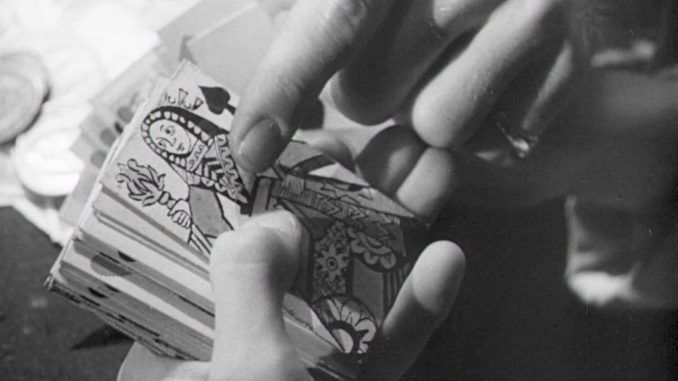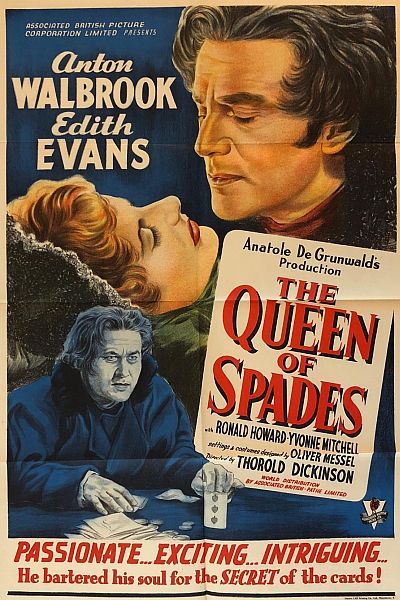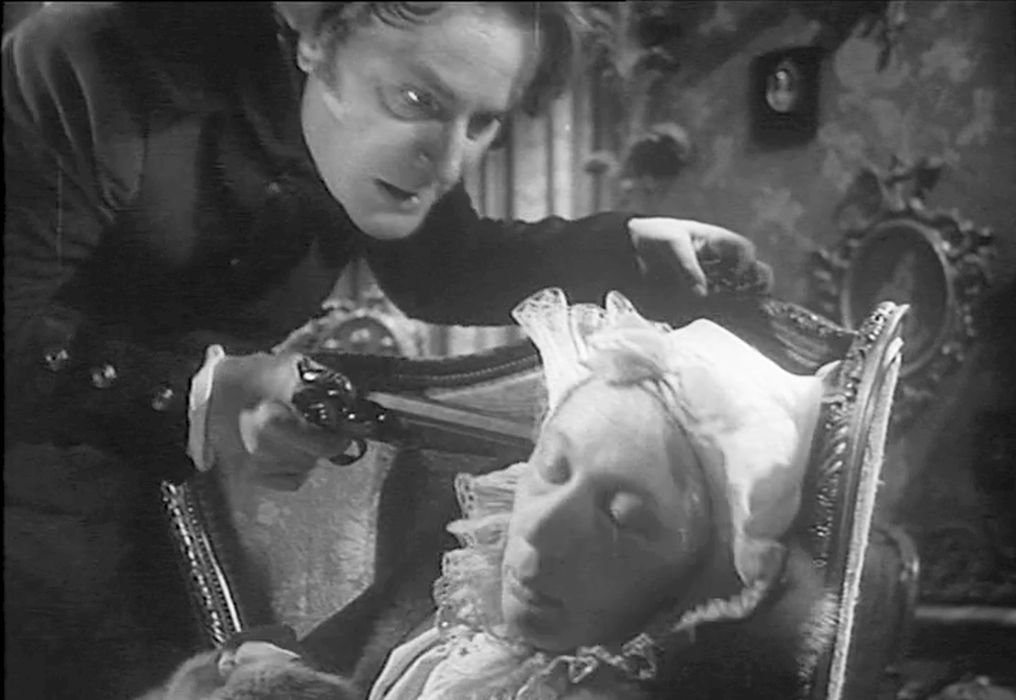
Rating: C+
Dir: Thorold Dickinson
Star: Anton Walbrook, Yvonne Mitchell, Edith Evans, Ronald Howard
A few more contenders for the year, this one just edging out Alias Nick Beal, although the latter seems to be more of a noir with Faustian overtones. At least I didn’t end up having to review Abbott and Costello Meet the Killer, which has Boris Karloff in brownface, proving that it wasn’t just Bela Lugosi who would demean himself for a quick buck. Queen is leagues above, not least in terms of aspirations. After spending a long time considered as a lost film, it has experienced something of a renaissance, finding new life both on DVD and in cinemas. Martin Scorsese is a big fan, calling it “one of the few real classics of supernatural cinema,” on its re-release in 2009.
Robert Eggers is another film-maker who appreciates it, citing The Queen of Spades as a significant influence on Nosferatu. “The fluidity and precision of the camera work and compositions was something we were trying to emulate, and the atmosphere is also incredibly effective. The snowy Russian streets is a sort of look and vibe we tried to create later in the film – particularly the ‘potato snowflake snowfall’ is very beautiful. and we use the same kind of practical snow.” Its modern impact is all the more impressive, considering Dickinson only came on board after original director Rodney Ackland had to drop out. Dickinson read the script on Wednesday, and was on set by the Saturday, then re-wrote the script, while it was being filmed.
 Given this, it’s remarkable the final product is so coherent, both in style and content. It helps that the underlying source material is strong, a work by Russian author Alexander Pushkin, first published in 1834. Though sometimes called a short story, it’s over 50,000 words, so has considerably more meat than say, The Fall of the House of Usher. It has been adapted for a variety of media, including an opera by Tchaikovsky, two radio plays (one starring Peter Lorre), and at least seven different film adaptations, beginning in 1910 with a Russian silent short. This was the first non-silent version, and also seems to be the only one of the movie adaptations made in the English language.
Given this, it’s remarkable the final product is so coherent, both in style and content. It helps that the underlying source material is strong, a work by Russian author Alexander Pushkin, first published in 1834. Though sometimes called a short story, it’s over 50,000 words, so has considerably more meat than say, The Fall of the House of Usher. It has been adapted for a variety of media, including an opera by Tchaikovsky, two radio plays (one starring Peter Lorre), and at least seven different film adaptations, beginning in 1910 with a Russian silent short. This was the first non-silent version, and also seems to be the only one of the movie adaptations made in the English language.
Save for the ending, which compacts three separate card games into one, it’s quite faithful to the original text. The setting is St. Petersburg in 1806, where the card-game faro is all the rage. Russian officer Captain Herman Suvorin (Walbrook) observes, but doesn’t gamble himself. However, he hears gossip about elderly aristocrat Countess Ranevskaya (Evans), who supposedly sold her soul to the devil in exchange for the secret to never losing at cards. Herman wants this, and seeks to ingratiate himself with the countess, through her young ward Lizaveta Ivanovna (Mitchell), which makes him a rival to comrade Andrei (Howard). So far, it has been more dark romance than horror, but the tone changes after Herman tries to pry the secret from the Countess – only to end up frightening her to death (below).
When Lizaveta discovers what happened, and Herman’s role in it, this doesn’t exactly endear him to her, obviously. There then follow a series of supernatural events, culminating in the ghost of the Countess finally providing Herman with the infallible series cards on which to bet – with one condition: he marries Lizaveta. She’s having none of it, but that doesn’t stop Herman from trying to use the information he was given. He liquidates all his assets and bets them on a game of cards with Andrei, insisting on this after his rival challenges Herman to a duel for his scandalous treatment of Lizaveta. It’s likely not a spoiler to say, these wagers end up going about as well as most deals with the devil usually go, even second-hand ones.
The look is great, with a lot of effort clearly put into the sets, costumes and period setting. The performances are a bit more variable. I wasn’t impressed with Walbrook, whose character has so few redeeming features, as to be actively repellent. But this is balanced by Evans – among the greatest stage actresses of the century – who is extraordinarily compelling as the Countess. Getting her was a real coup, this being her first feature in thirty-three years. Remarkably, despite looking 70 going on 120, her career peak was still a decade and a half away. For in the mid-sixties, she’d be nominated three times for an Oscar. Valentine Dyall and Miles Malleson are in the supporting cast, and a special shout-out to Ivor Barnard, as a bookseller who emphatically chews the scenery to great effect.
 I just wish it hadn’t spent so much time, frankly, faffing around in the first half. There’s so much to appreciate in the later stages, from little things like the Countess apparently opening her eyes during her funeral, to the highly tense set piece of the final card-game, you wonder what happened in the early going. We didn’t need, for example, an extended flashback of Herman reading a book which tells the story of the Countess selling her soul. It’s something which can simply be stated, and we then move on. Or quite so many gypsy musical numbers. It’s easy to understand why the contemporary reviews were mixed.
I just wish it hadn’t spent so much time, frankly, faffing around in the first half. There’s so much to appreciate in the later stages, from little things like the Countess apparently opening her eyes during her funeral, to the highly tense set piece of the final card-game, you wonder what happened in the early going. We didn’t need, for example, an extended flashback of Herman reading a book which tells the story of the Countess selling her soul. It’s something which can simply be stated, and we then move on. Or quite so many gypsy musical numbers. It’s easy to understand why the contemporary reviews were mixed.
That said, it was still nominated for a BAFTA as Best British Film that year. It lost out to The Third Man, albeit in a stacked field which also included a slew of classics, including Kind Hearts and Coronets. If this was likely the peak year for Ealing comedies, this was, once again, ploughing close to a lone furrow for British horror in the year. I’m not sure why there was such a dearth in the genre at this point. I’m inclined to suggest perhaps post-war optimism, with the real-life horrors recently experienced having diminished the desire for watching fictional ones. But if there’s a lack of quantity, this is decent enough to make me wonder why no remake from the same book has been attempted.
This article is part of our October 2025 feature, 31 Days of Vintage Horror.
